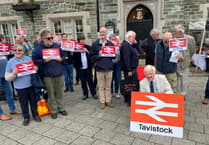A pioneering environmental explorer from West Devon is planning two expeditions, one by land and one by sea in the next few months to support the NASA space agency research into climate and other changes and how they are affected by man’s activities.
Jim McNeill runs the Global Warrior Project from Princetown on Dartmoor, an aptly remote place, where he trains ordinary people to be citizen scientists and to embark on valuable data-gathering expeditions in extreme environments such as deserts, oceans and ice fields.
The data measures ice thickness and coverage, landscape evolution, air pollution and other indicators of larger global changes which will be supplied to NASA and other scientific organisations.
His work and love of the natural world backs the messages of high-profile figures such as campaigner David Attenborough - for whom he worked as advisor and trainer on acclaimed programmes such as Frozen Plant, Human Planet and the Natural World series through the renowned BBC Natural History Unit.
Following in the footsteps of great explorers such as Shackleton, Jim is currently training sponsored volunteers on Dartmoor from ordinary backgrounds who are motivated by the huge concern over the environment to put themselves through physical and mental stresses by going to the Northern Pole of Inaccessibility - the furthest point on the Arctic sea ice from any land mass. Jim himself surveyed this point, but such is the degree of global warming, that ice melt prevented him reaching it.
He has nearly died at least once due to rapidly increasing ice melt, but this only adds to his characteristic determination to succeed and is taking special sleds which can float on the inevitable areas of melted ice.
His Ice Warrior project is backed by people with similar action-man attitudes and resilience, such as patron and famous explorer Sir Ralph Fiennes who said the project is typically eccentrically British, but he had the utmost confidence in Jim’s quite confidence, skills and leadership. Jim said: ‘We’re taking people from all walks of life on an extraordinary experience, but one which they will all value for ever. ‘They will have one of the most important motivations of this century, to monitor global changes and support scientists in giving governments and other agencies invaluable evidence of climate change.
‘Although scientific papers typically take a few years to be published such as the recent Intergovernmental Panel on Climate Change report, our evidence gives an anecdotal snap shot of a moment in time. It adds to the general picture, so we might be five years out of date on the climate emergency. Things might well be worse than we think.’
His amateur scientists, including local people, cannot have a better person to lead them into the dangerous and hostile Arctic.
What better way to prepare to survive the most inhospitable place than to learn from the Inuit - Jim did that by living and working with them when working on breaks in a previous life as a fireman for Berkshire Fire and Rescue Service and separately as a fire prevention fire officer for the Royal Family. His fire service experience and earlier Army training in Norway all equipped him with crisis and man-management skills.
He credits them with helping him learn how to survive close proximity with wolves and polar bears - having even written a training manual on how to live with the bears. He said: ‘They are the experts, so it makes sense and I fitted it in between my two fire officer jobs. I learned how to make the most of the animals they rely on to eat and to keep warm. Basically, I learned how to survive. And of course, our research immediately addresses their very existence on the ice they live on.’
He has an Inuit hunting team to thank for saving his life when he fell into polar ice slush while on an expedition: ‘It was the closest I came to thinking I’d ended my stint on earth. I just thought about my wife and two children and made up my mind if I was going down, I’d go down fighting.’ He made it to solid ice and was taken by snow mobile to a special camp set up for him to recover, but not before the mobile overturned, trapping his leg briefly.
Jim’s do-or-die attitude, love of outdoors and interest in science and the health of the environment started long before he became an explorer.
He admits to being non-academic in the traditional way and a ‘naughty’ boy at school. He left university to work for the Grasslands Institute as right-hand man to an eminent scientist Dr John Ryden who was measuring the effect of fertilizer nitrogen on the environment.





Comments
This article has no comments yet. Be the first to leave a comment.